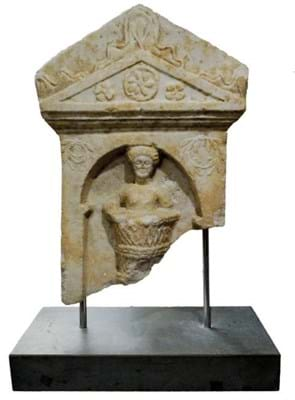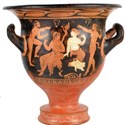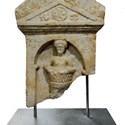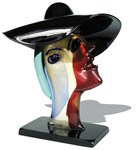Two points characterised the lots from a private Warwickshire collection.
One was a sound provenance – the collector was a friend of historian/archaeologist Arthur Dale Trendall, who used pieces from the collection to illustrate his books.
The second was the continued affordability of attractive material made two millennia and more ago, as supply remains amply sufficient to meet modest demand.
For instance, a 4in (10cm) long Roman oil lamp with bee decoration to the top and foot made a triple-estimate £130; a 5in (12.5cm) diameter Egyptian alabaster dish certified to 2950-2575BC went on its lower estimate of £70 and a 10in (25cm) wide Greek Campanian kylix (a shallow two-handled wine bowl) from c.335BC with some chips and restoration doubled expectations at £400.
Highest price
Top-seller was a large Greek red-figure bell krater, c.380-330BC, attributed to the Athenian painters working in Sicily. The 11½in (29cm) tall vessel – used for mixing wine and water – was pitted and had some restoration but left the £200-400 estimate behind, selling to a Californian collector at £3100.
Also from ancient Greece was a c.330BC plate, 7in (18cm) diameter, with a profile portrait of a young women within a leaf border.
It had some restoration and minor repainting but, given that the only other known example with this decoration is in the Vienna Museum, looked temptingly estimated at £150-250. It sold to a UK collector at £940.
The Californian buyer was back in action to secure the top Roman lot.The 2nd/3rd century AD marble stele was carved with a baptismal scene.
It was lacking about 15% of its original form but was attractive enough to be the catalogue back-cover illustration and went at its lower £2000 estimate.
The comparative value of such antiquities was reflected towards the end of the two-day sale when furniture and architectural were offered, including a pair of Italian 19th century marble columns often described as ‘after the antique’.
Standing 5ft 8in (1.72m) tall, each had brass scrolling capitals and square section feet decorated with acanthus leaves. Both had condition problems, one with a repaired horizontal break through the middle, the other with a section broken to the top.
Nevertheless, the pair, estimated at £2000- 3000, sold to a UK dealer at £5800.
Wide-ranging sale
Elsewhere in the wide-ranging sale, a 19th century satinwood and painted dressing table described as of exhibition quality took a mid-estimate £7800.
Meanwhile, an early 19th century Scottish Highland flintlock all-steel belt pistol by MacLeod in original condition doubled hopes, going to a UK specialist at £5800.
Contender for the biggest surprise of the two days was a yellow and green glazed model of a stylised lion made in the pottery-producing Turkish port of Canakkale in the 19th century.
Standing 9in (23cm) tall, it suffered some minor losses and chips but, against a £40-60 estimate, sold to a specialist Turkish dealer at £2050.


















